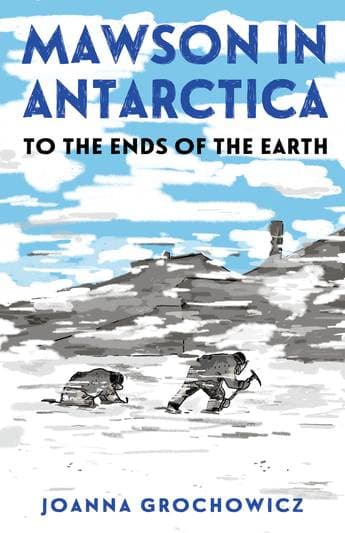Review: Mawson in Antarctica, by Joanna Grochowicz
Reviewed by Erica Stretton
Mawson in Antarctica, the fourth of Joanna Grochowicz’s non-fiction titles centred on Antarctic expeditions, is a slim novel-sized book with a few leaves of photographs in the centre. Written as an engaging adventuristic narrative, it is aimed at 10-14 year old readers and the style is not too weighty, entirely readable. A list of the expedition’s adventurers, an artist’s rendering of the group, and two maps sit at the beginning of the book.
But it doesn’t necessarily look like a children’s non-fiction book. I looked back at reviews of Grochowicz’s previous titles and found Dionne Christian and Zoe Gadd’s engaging review for Kete here. The first sentence of that review is ‘who is this book for?’ and as that was my first thought on encountering Mawson in Antarctica, I was encouraged that this review team had ultimately been fascinated by Shackleton’s Endurance.
But although the titles are in the same style, Mawson’s expedition to the uncharted section of Antarctica, directly below Australia’s south coast, seems less eventful. Mawson in Antarctica begins with the arrival of the ship Aurora to Antarctica, the introduction of the men, and the origins of the expedition. Mawson, the leader of the party, on arrival back from Shackleton’s journey in 1909, said he would never venture to Antarctica again. Yet by 1912 he's back, unable to resist the lure of unchartered ground.
Trials and tribulations occur as the team is transferred to the ice at a headland they name Cape Dennison, and begin to build the base they’ll stay in for most of the year. The relentless wind and weather hampers their work. This theme runs through the book, reminding us that nature isn’t to be messed with, and that in a place like Antarctica in 1912 humans don’t have the upper hand. The early narrative also details the relationships between these men; those who are tolerant, those who aren’t; those who muck in to work and those who skive off, unable to cope with the treacherous cold. These relationships are crucially important when survival depends on teamwork.
Weathering the winter and building a base covers the first two-thirds of the book. Several shorter chapters, stepping back on the timeline and covering Mawson’s fight to get his expedition underway and provide context, punctuate this first section of the narrative. The most exciting action is in the later half, as the group sets out on the springtime mapping expeditions into the east that are the purpose of the expedition.The last nine chapters are intrepid, adventurous, heartbreaking, exciting. But they come late in the timeline.
Unlike Zoe and Dionne, my two younger readers read several chapters and then drifted away. ‘It was interesting,’ the twelve year old said, and shrugged, and didn’t pick the book up again. Perhaps I should have read it to them, explaining context as I went? But they prefer to read alone now, and the subject, while fascinating, perhaps reached further in detail and truth than they were ready for.
Joanna Grochowicz has brought forth a fascinating world of exploration and courage which will thoroughly engage those who have already enjoyed Shackleton’s Endurance. But readers a little older than suggested may be better placed to engage more wholly with the narrative, and understand the relentless tribulations these men went through in the name of science and exploration.
Reviewed by Erica Stretton
